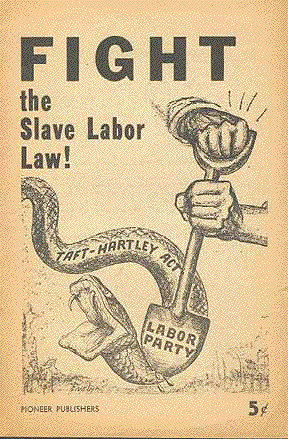February 08, 2005
Right-to-work... for less money and an early death

|
Unions have been on my mind lately, for a variety of reasons, and I thought that it was high time to address the right-to-work issue.
Right-to-work is part of the Taft-Hartley act of 1947:
"In the face of the workers' determination to resist Wall Street's attack, Congress nevertheless steamrollered through the savage Taft-Hartley Act...."Truman's conduct on anti-labor legislation affords a striking example of how a Wall Street political chieftain operates. He took the lead in the labor-hating drive of 1946. He threatened the miners and seamen with military force. He smashed the railroad strike. He called a special joint session of Congress to demand shot-gun passage of a law to draft strikers and force them back on the job at the point of a bayonet....
"The Republicans and Democrats in Congress took their cue from Truman. As they vied with each other in cooking up the harshest anti-labor laws, Truman--looking ahead to the 1948 elections--changed his tactics....He became silent, uttering no protest as the Taft-Hartley Act was slicked through Congress.
"Then, at the last hour, Truman made his grandstand play for labor support by a belated veto....As for the Democrats in Congress...they gave a decisive majority to the Slave Labor Law--voting 106 to 71 in the House and 20 to 22 in the Senate."
Specifically, right-to-work
laws undermine the ability to build effective unions by creating a free-rider problem -- workers can enjoy the benefits of union membership in a workplace without actually joining the union or paying union dues. Right-to-work laws increase employer leverage to resist unions by enabling them to benefit from free riders; and vastly decrease union membership, thus dramatically diminishing unions' bargaining power.
Unions are responsible for the weekend, for the eight hour workday, for paid holidays and vacations, and for countless other benefits that most working people now take for granted. Recently, union members have been able to stave off many of the cuts in benefits that non-union workers have had to suffer.
Almost all union workers - 89 percent - have access to employer-provided medical benefits, compared with 67 percent of nonunion workers. Seventy-three percent of union workers have dental care coverage, compared with 43 percent of nonunion workers. For vision care, 56 percent of union workers receive benefits; only 26 percent of nonunion workers are covered.The advantages of union membership also show in whether or not employees must pay for part of their health care benefits. For single coverage, the employer pays all costs for 43 percent of union workers, but only 21 percent of nonunion workers receive employer-paid coverage.
For family coverage, 33 percent of all union workers are not required to contribute, but only 7 percent of nonunion workers receive coverage that is fully paid by the employer.
When union members are required to contribute toward their health care coverage, they pay far less than nonunion workers. The average flat contribution for single coverage for union members is $56.53 a month, or $678.36 per year, compared with $68.98 per month, or $827.76 per year for nonunion workers.
For family coverage, union members contribute an average of $195.12 a month, or $2,341.44 a year, compared with $273.51 a month, or $3,282.12 per year, for nonunion workers.
Nonunion workers face much higher costs for medical coverage than they did only a few years ago. The average annual nonunion employee contribution for family coverage is $1,052.64 more today than it was in 2000.
Overall, employers pay 83 percent of the cost of health care benefits for family coverage for union workers, but only 67 percent of the costs for nonunion workers.
Fifty-nine percent of workers have access to retirement benefits, with 50 percent participating in at least one type of retirement plan. The vast majority of these workers are covered only by a defined contribution plan, such as a 401(k), and the data do not reveal the size of the retirement accounts for these workers.
Only 21 percent of all workers are covered by defined benefit retirement plans, which are primarily traditional employer-funded pension plans with a predetermined retirement benefit paid out for life after retirement. Only 10 percent of all private sector establishments still offer these plans. This benefit is now really a union benefit, with 70 percent of all union workers covered by a defined benefit plan, compared with only 16 percent of nonunion workers.
Fifty-three percent of all workers are covered by defined contribution retirement plans, which are largely funded by the workers themselves. Among union workers, 48 percent are covered by these plans, which are often offered in addition to pension plans at union workplaces.
The union advantage extends well beyond health and retirement benefits. Union workers are more likely to receive employer-provided life insurance and twice as likely to have short-term disability coverage.
Union workers are also more likely to receive paid time-off benefits and greater amounts of paid time-off. For example, union workers with 20 years of service receive an average of 22.3 paid vacation days, compared with 18.1 days for nonunion workers.
Unions have also been able to maintain larger wage increases for their members, with annual wage cost increases averaging 3.0 percent for union workers and 2.5 percent for nonunion workers from September 2003 to September 2004. Largely because of the rising cost of benefits, total compensation costs for union workers rose 5.8 percent, compared with 3.4 percent for nonunion workers. This growing differential in union and nonunion costs will fuel greater employer opposition to organizing drives going forward.

|
Which brings us back to right-to-work.
“Right to work” has nothing to do with a right to a job or employment. The deceptively named “right to work” laws ban workers—who by a majority vote decided to form a union in their workplace—and employers from negotiating union security clauses. By law, unions must represent all workers—members and nonmembers—in contract negotiations and other workplace issues. A “right to work” law would allow nonmember workers to get all the benefits of union membership and pay nothing, while forcing unions and their members to foot the bill for those not willing to pay their share. The result is weaker unions with inadequate resources to represent members.In the 28 non-“right to work”states, federal law protects those workers who do not want to join the union. Workers in those states are required to pay only a fair share to cover the costs of their union representation, but not the cost of a union's political, legislative, social or charitable activities.
It's really a 'right to work for less'
It's no coincidence that some employer groups, Big Business and ultraconservative lawmakers back “right to work”laws because such laws weaken unions and in turn depress wages. Studies show that workers in “right to Work” states earn significantly less, while workers in non-“right to work” states earn significantly more. A primary reason is that workers with a union contract earn higher pay—weakening unions lowers average pay. Workers of color and women workers who are union members make significantly higher wages.
The average worker in a “right to work” state earns about $5,333 less a year than workers in other states. (source: Bureau of Labor Statistics, 2001)
Hispanic union members earn 45 percent ($180) more a week than nonunion Hispanic workers. (source: Bureau of Labor Statistics, Jan. 2002 )
African Americans earn 30 percent ($140) more a week if they are union members. (source: Bureau of Labor Statistics, Jan. 2002)
Union women earn 30 percent more ($149) a week than nonunion women. (source: Bureau of Labor Statistics, Jan. 2002)
...“Right to work” laws reach far beyond wages. Quality-of-life issues such as health care, education, worker safety and poverty suffer greatly in “right to work” states.
In “right to work” states 21 percent more people are without health insurance compared with those in free-bargaining states. (source: State Rankings 2000, A Statistical View of the 50 United States, Morgan Quinto Press)
“Right to work” states spend $1,699 less per elementary and secondary pupil than other states. (source: Education Vital Signs, 2000–2001 school year)
The infant mortality rate in “right to work” states is 17 percent higher than in other states, and the poverty rate is 12.5 percent compared with 10.2 percent in other states. (source: State Rankings 2000, A Statistical View of the 50 United States, Morgan Quinto Press; U.S. Census Bureau, Current Population Survey, March 2002)
The rate of workplace death is 51 percent higher in “right to work” states. (source: Bureau of Labor Statistics, 2001; AFL-CIO, “Death on the Job,” April 2002)
It’s clear that living in a right-to-work state tends to drastically reduce one’s standard of living, and the only people to benefit are those who profit unfairly from the under-compensated worker. This group includes CEOs who pay themselves 500 times what their workers earn as well as the politicians who support the legalized theft of labor.

|
Simply put, joining and actively supporting a union allows you as a worker to take back a little bit of what you deserve, and if you live and work in a right-to-work state and you enjoy a union negotiated contract without joining the union, if you are a free rider, your short sighted selfishness is contributing to the slow death of organized labor.
More:
Pamphlets in the Fight Against Taft-Hartley 1947-1948
How to Organize a Union in Your Workplace
'Right to Work' States Are Really Restricted Rights States (AFL-CIO)
Posted by Norwood at February 8, 2005 11:42 PM